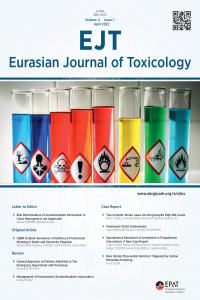Neutropenic Toxic Epidermal Necrolysis Due to Sulfonamide Use
Nötropeni, Kotrimaksazol, Toksik epidermal nekroliz
Neutropenic Toxic Epidermal Necrolysis Due to Sulfonamide Use
toxic epidermal necrolysis, neutropenia, cotrimoxazole,
___
- 1. Gleckman, R., N. Blagg, and D.W. Joubert. Trimethoprim: mechanisms of action, antimicrobial activity, bacterial resistance, pharmacokinetics, adverse reactions, and therapeutic indications. Pharmacotherapy, 1981. 1(1): p. 14-20.
- 2. Dodiuk-Gad, R.P., et al. Stevens-Johnson Syndrome and Toxic Epidermal Necrolysis: An Update. Am J Clin Dermatol, 2015. 16(6): p. 475-93.
- 3. Roujeau, J.C. The spectrum of Stevens-Johnson syndrome and toxic epidermal necrolysis: a clinical classification. J Invest Dermatol, 1994. 102(6): p. 28S-30S.
- 4. Duncan, K.O., R.E. Tigelaar, and J.L. Bolognia, Stevens-Johnson syndrome limited to multiple sites of radiation therapy in a patient receiving phenobarbital. J Am Acad Dermatol, 1999. 40(3): p. 493-6.
- 5. Roujeau, J.C. and R.S. Stern. Severe adverse cutaneous reactions to drugs. N Engl J Med, 1994. 331(19): p. 1272-85.
- 6. Mockenhaupt, M. Severe drug-induced skin reactions: clinical pattern, diagnostics and therapy. J Dtsch Dermatol Ges, 2009. 7(2): p. 142-60; quiz 161-2.
- 7. Shear, N.H., et al. Differences in metabolism of sulfonamides predisposing to idiosyncratic toxicity. Ann Intern Med, 1986. 105(2): p. 179-84.
- 8. Revuz, J., et al. Toxic epidermal necrolysis. Clinical findings and prognosis factors in 87 patients. Arch Dermatol, 1987. 123(9): p. 1160-5.
- 9. Gueudry, J., et al. Risk factors for the development of ocular complications of Stevens-Johnson syndrome and toxic epidermal necrolysis. Arch Dermatol, 2009. 145(2): p. 157-62.
- 10. Meneux, E., et al. Vulvovaginal involvement in toxic epidermal necrolysis: a retrospective study of 40 cases. Obstet Gynecol, 1998. 91(2): p. 283-7.
- 11. Fernando, S.L. The management of toxic epidermal necrolysis. Australas J Dermatol, 2012. 53(3): p. 165-71.
- 12. Kirchhof, M.G., et al. Retrospective review of Stevens-Johnson syndrome/toxic epidermal necrolysis treatment comparing intravenous immunoglobulin with cyclosporine. J Am Acad Dermatol, 2014. 71(5): p. 941-7.
- 13. Paradisi, A., et al. Etanercept therapy for toxic epidermal necrolysis. J Am Acad Dermatol, 2014. 71(2): p. 278-83.
- Yayın Aralığı: Yılda 3 Sayı
- Başlangıç: 2019
- Yayıncı: Acil Tıp Uzmanları Derneği
Retrospective Analysis of Geriatric Intoxication Cases
Özlem BİLİR, Alpaslan ÜNLÜ, Gökhan ERSUNAN, İsmail ATAŞ
Antiviral Drugs and Their Toxicities
Muhammed EKMEKYAPAR, Şükrü GÜRBÜZ
Psychiatric Evaluation of Suicidal Drug Intake in the Emergency Department
Hatice Şeyma AKÇA, Serdar ÖZDEMİR, Kamil KOKULU, Abdullah ALGIN, Serkan Emre EROĞLU
Neutropenic Toxic Epidermal Necrolysis Due to Sulfonamide Use
Handan BİLEN, Haticetül Kübra SARI
Sıvı Gübre İnhalasyonu: Olgu Sunumu
Emel YILDIZ, Filiz ÖZYİĞİT, Mustafa ÇETİNER
Ömer Faruk GEMİŞ, Abdullah Osman KOÇAK
